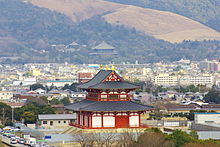- Heijō Palace
-
Heijō Palace (平城宮 Heijō-kyū) in Nara, was the Imperial Palace of Japan (710-784 AD), during most of the Nara period. The Palace was located in the north end of the capital city, Heijō-kyō. The remains of the palace, and the surrounding area, was established as a UNESCO World Heritage Site in 1998 along with a number of other buildings and area, as the "Historic Monuments of Ancient Nara."
Contents
History
After Empress Genmei's succession to Imperial Throne in 707, there was much discussion about the transfer of the palace. A year later, a rescript was issued deciding on the move to Nara. In 710, the new capital officially takes over, but the completion of the palace had to wait further.[1] (Written Heijō (平城) but also pronounced Nara at the time, the land gains its synonym, Nanto (南都, 'Southern Capital') as opposed to Kyoto, the capital in the North, centuries later.)
The city, and the palace grounds, was based largely on Chang'an (present-day Xi'an), the capital of China during the Tang Dynasty, which was contemporary to the time when Nara was capital of Japan. Chang'an was in turn, like many ancient East Asian cities, based on a complex system of beliefs & laws of geomancy. This dictated the grid system of streets, as well as the necessity for spiritually protective shrines or temples to be placed at particular cardinal directions around the city.
In accordance with this system, the Palace was placed at the northern end, on an extended line from Suzaku Street, the main thoroughfare running north-south straight through the center of the city. The street ended at the Suzaku-mon, depicted above, and the rest of the Palace buildings were then placed beyond to the north of this gate. The primary buildings of the Palace compound were the Daigoku-den, where governmental affairs were conducted, the Chōdō-in where formal ceremonies were held, the Dairi, the Emperor's residence, and offices for various administrative agencies. The foundations or footprints of these buildings are still visible on the site.
There was a former and a later palace.
When the capital was moved to Heian-kyō (now called Kyoto), Nara's Imperial Palace was simply abandoned. Over the ensuing centuries, the ravages of time and the elements slowly destroyed the buildings, until by the beginning of the Kamakura Period in the late 12th century there was practically nothing left above ground. However, those sections that lay underground were preserved, and re-discovered by modern archaeologists.[2]
While the site was designated Special Historical Site by the Agency for Cultural Affairs in 1952, archaeological efforts headed by the National Research Institute for Cultural Properties, such as excavations are continuing since 1959. The Suzaku-mon and Tou-in Garden have been restored and opened to the public in 1998.
Commemorative events of the 1300th anniversary
Heijō Palace is the Main Event Site of Commemorative events of the 1300th anniversary of Nara Heijō-kyō Capital (Japanese:平城遷都1300年祭) in 2010, and the First Daigokuden(第一次大極殿) have been restored. In commemorative events of the 1300th anniversary, a variety of seasonal events will be held throughout Nara Prefecture from April 24 to November 7, 2010. The outline of Commemorative events of the 1300th anniversary in Heijō Palace is the following list.
- Main Event Site - Heijō-kyō Capital Area (Heijō Palace)
A:Entrance Plaza
●Heijō Palace Site Tour Center (探訪ツアーセンター)
●Corporate Participation Hall (出展参加ホール)
B:Heijō History Museum (平城宮跡資料館)
Full-Scale Replica of Japanese Diplomatic Ship for Envoys to Tang China (遣唐使船復原展示)
C:Suzaku Gate Plaza
●Suzaku Gate (Suzakumon, 朱雀門)
D:Exchange Plaza
●Mahoroba Stage (まほろばステージ)
●Exchange Hall (交流ホール)
E:Heijō Palace Site Museum (平城宮跡資料館)
F:Front Courtyard of the Former Imperial Audience Hall (the First Daigokuden, 第一次大極殿・前庭)
G:South Gate Plaza
●Tenpyo period costume rental area (天平衣装貸出所)
H:Heijō-kyō Hands-on Learning Plaza (体験学習広場)
●Heijō-kyō Hands-on Learning Center (平城京なりきり体験館)
●Ministry of the Imperial Household (宮内省)
I:Excavation Site Exhibition Hall (遺構展示館)
J:Eastern Palace Garden Plaza
●Eastern Palace Garden (Tōin Teien garden, 東院庭園)Transport
It takes 15 or 20 minutes to walk from Yamato-Saidaiji Station to Heijō Palace. And between May and August in 2010, the free shuttle bus runs between Yamato-Saidaiji Station, JR Nara Station and Heijō Palace every 10 or 15 minutes.
See also
- Heijō-kyō
- Heian Palace
- Nara period
- Capital of Japan
- List of Special Places of Scenic Beauty, Special Historic Sites and Special Natural Monuments
References
- ^ "National Research Institute for Cultural Properties". http://www.nabunken.go.jp/. Retrieved 2007-03-09. Navigate to English page from top menu bar
- ^ image showing placement of pillars
External links
 Media related to Heijō Palace at Wikimedia Commons
Media related to Heijō Palace at Wikimedia Commons- Official UNESCO page
- Geomancy and Imperial Position in Nara
- The Commemorative Events for the 1300th Anniversary (Available in Chinese, English, French, Korean and Japanese)
Imperial Palaces and residencies in Japan Occupied Tokyo Imperial Palace • Tōgū Palace • Akasaka Estate • Higashi Residence • Takanawa Residence • Sanbanchō Residence • Kyoto Imperial Palace • Kyoto Ōmiya Palace • Sentō Imperial Palace • Katsura Imperial Villa • Shugakuin Imperial Villa • Nasu Imperial Villa • Hayama Imperial Villa • Suzaki Imperial Villa
Historical Akasaka Palace • Heian Palace • Fukuhara Palace • Nagaoka Palace • Heijō Palace • Shigaraki Palace • Naniwa Palace • Kuni Palace • Fujiwara Palace • Palaces of Asuka • Ōtsu Palace • Nagaratoyosaki Palace • Kudara Palace • Takatsu Palace • Teien PalaceCoordinates: 34°41′28″N 135°47′44″E / 34.69111°N 135.79556°E
Tōdai-ji · Kōfuku-ji · Kasuga Shrine · Gangō-ji1 · Yakushi-ji · Tōshōdai-ji · Heijō Palace · Kasugayama Primeval Forest1 Gangō-ji Gokurakubō
Categories:- 710s architecture
- World Heritage Sites in Japan
- Imperial residences in Japan
- Former buildings and structures of Japan
- Former palaces
- Nara period
- Special Historic Sites
Wikimedia Foundation. 2010.









